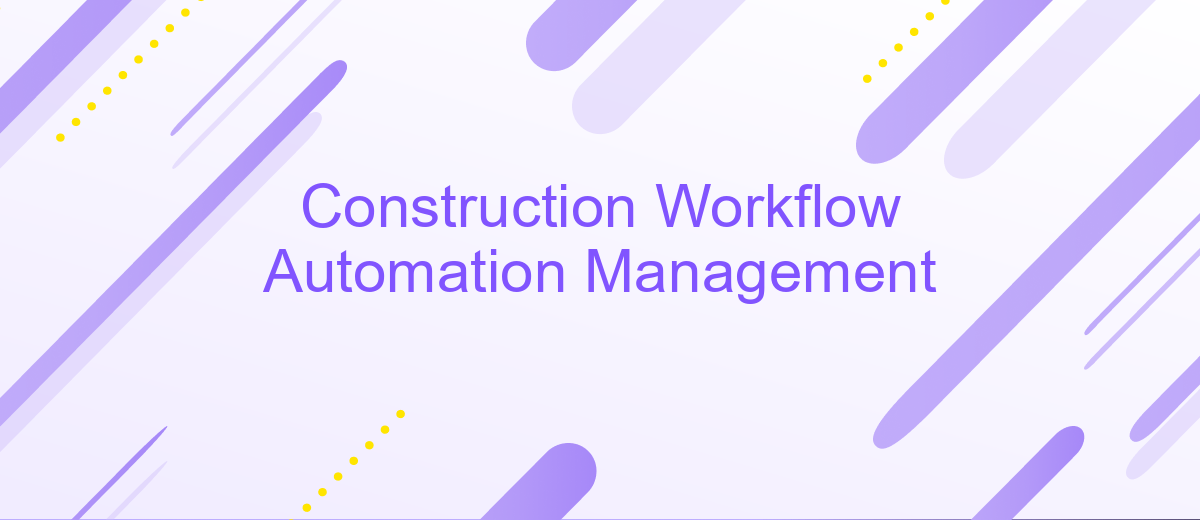Construction Workflow Automation Management
In the rapidly evolving construction industry, efficient management of workflows is paramount to success. Construction Workflow Automation Management (CWAM) offers a transformative approach, leveraging advanced technologies to streamline processes, enhance productivity, and reduce errors. This article delves into the benefits and implementation strategies of CWAM, highlighting its potential to revolutionize project management and deliver superior outcomes in the construction sector.
Introduction
In the rapidly evolving construction industry, the need for efficient workflow automation has never been more critical. Construction projects are becoming increasingly complex, requiring seamless coordination between various stakeholders, including architects, engineers, contractors, and suppliers. Effective workflow automation can significantly enhance productivity, reduce errors, and ensure timely project completion.
- Streamlining communication between project teams
- Automating routine tasks and documentation
- Integrating various software tools and platforms
- Enhancing data accuracy and accessibility
- Improving project tracking and reporting
One of the essential aspects of construction workflow automation is the integration of different software systems. Services like ApiX-Drive facilitate this integration by allowing seamless data transfer between various applications. By leveraging such tools, construction companies can ensure that all project-related information is synchronized, reducing the risk of discrepancies and enhancing overall efficiency. As a result, construction firms can focus more on strategic decision-making and less on manual data handling, leading to more successful project outcomes.
Benefits of Construction Workflow Automation Management

Construction workflow automation management significantly enhances project efficiency by streamlining and automating repetitive tasks. This leads to reduced manual errors, faster project completion times, and improved resource allocation. Automated workflows ensure that every team member is on the same page, which minimizes miscommunication and enhances collaboration. This level of coordination is crucial in complex construction projects where even minor delays can lead to significant cost overruns.
Another key benefit is the integration of various tools and platforms through services like ApiX-Drive. This allows for seamless data transfer between different software systems, ensuring that all project information is up-to-date and easily accessible. ApiX-Drive facilitates the connection of CRM systems, project management tools, and other essential applications, thereby creating a unified ecosystem. This not only saves time but also enhances decision-making by providing real-time insights into project status, resource utilization, and potential bottlenecks.
Challenges in Implementing Construction Workflow Automation Management

Implementing construction workflow automation management presents several challenges that can hinder its effectiveness and efficiency. These challenges often stem from the complexity and scale of construction projects, as well as the need for seamless integration of various tools and systems.
- Integration Complexity: Integrating multiple software solutions to create a cohesive workflow can be daunting. Services like ApiX-Drive can simplify this process by automating data transfer between different platforms, reducing manual effort and errors.
- Employee Resistance: Workers accustomed to traditional methods may resist adopting new technologies. Proper training and demonstrating the benefits of automation can help mitigate this resistance.
- Data Security: Ensuring that sensitive project data is secure when using automated systems is crucial. Implementing robust security measures and choosing reliable automation tools are essential steps.
- High Initial Costs: The upfront investment for automation tools and training can be significant. However, the long-term benefits often outweigh these initial expenses.
Addressing these challenges requires a strategic approach, including selecting the right automation tools, such as ApiX-Drive for seamless integrations, providing adequate training, and ensuring robust data security. By overcoming these hurdles, construction companies can fully leverage the benefits of workflow automation.
Best Practices for Successful Implementation

Implementing construction workflow automation management effectively requires a strategic approach. Begin by thoroughly understanding your current workflows and identifying areas that can benefit the most from automation. Engage with your team to gather insights and ensure that everyone is on board with the upcoming changes.
Next, choose the right tools and technologies that align with your specific needs. It’s crucial to select platforms that offer scalability and flexibility to adapt to your evolving requirements. For instance, integrating various software solutions using ApiX-Drive can streamline your processes and enhance overall efficiency.
- Conduct a comprehensive workflow analysis.
- Select scalable and flexible automation tools.
- Engage with stakeholders for smooth implementation.
- Regularly monitor and adjust workflows as needed.
Finally, continuous improvement is key. Regularly review and optimize your automated workflows to ensure they remain efficient and effective. Training your team on new tools and processes will further enhance the success of your implementation, leading to a more productive and streamlined construction management system.
Conclusion
In conclusion, the implementation of construction workflow automation management can significantly enhance the efficiency and productivity of construction projects. By streamlining processes, reducing manual errors, and improving communication among team members, automated systems can lead to faster project completion times and cost savings. The integration of various digital tools and platforms ensures that all aspects of the project are synchronized and accessible in real-time, fostering a more collaborative and transparent working environment.
Moreover, utilizing integration services like ApiX-Drive can further optimize the workflow by seamlessly connecting different applications and systems used in construction management. This allows for the automatic transfer of data and updates across platforms, minimizing the need for manual intervention and reducing the risk of data discrepancies. As the construction industry continues to evolve, embracing automation and integration technologies will be crucial for staying competitive and delivering high-quality projects efficiently.
- Automate the work of an online store or landing
- Empower through integration
- Don't spend money on programmers and integrators
- Save time by automating routine tasks
FAQ
What is Construction Workflow Automation Management?
How can automation improve communication in construction projects?
What are the key benefits of implementing workflow automation in construction?
How do I start implementing workflow automation in my construction projects?
Can workflow automation be customized for different types of construction projects?
Time is the most valuable resource for business today. Almost half of it is wasted on routine tasks. Your employees are constantly forced to perform monotonous tasks that are difficult to classify as important and specialized. You can leave everything as it is by hiring additional employees, or you can automate most of the business processes using the ApiX-Drive online connector to get rid of unnecessary time and money expenses once and for all. The choice is yours!


